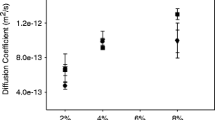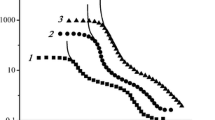Abstract
The polymerization conditions have a strong influence on the properties and time-dependent behavior of a sessile water drop on polymer films. For a given copolymer composition, the recipe components of emulsion copolymer films clearly influence the initial static water contact angle. Common emulsifiers such as sodium dodecyl sulfate lead to lower contact angles than poly(ionic liquid) dispersions which are a new class of stabilizers for emulsion polymerization. In contrast to the static contact angle, the time-dependent properties of the water contact angle reflect the particular conditions during the polymerization. It is a general conclusion of this study that waterborne emulsion copolymers show a distinctly different time-dependent behavior of the contact angle than bulk polymers of the same molecular composition regardless of the initial static contact angle.





Similar content being viewed by others
References
Rozik N, Antonietti M, Yuan JY, Tauer K (2013) Polymerized ionic liquid as stabilizer in aqueous emulsion polymerization enables a hydrophilic–hydrophobic transition during film formation. Macromol Rapid Comm 34 (8):665–671. doi: 10.1002/marc.201200827
Johnson RE, Dettre RH (1993) Wetting of low-energy surfaces. In: Berg JC (ed) Wettability. Marcel Dekker, Inc., New York, pp 1–73
Yuan J, Antonietti M (2011) Poly(ionic liquid) latexes prepared by dispersion polymerization of ionic liquid monomers. Macromolecules 44(4):744–750
Tauer K, Khrenov V (2002) Polymer dispersions as intermediate state during the synthesis of specialty polymers. Macromol Symp 179:27–52. doi: 10.1002/1521-3900(200203)179:1<27::Aid-Masy27>3.0.Co;2–9
Topp MDC, Leunen IH, Dijkstra PJ, Tauer K, Schellenberg C, Feijen J (2000) Quasi-living polymerization of N-isopropylacrylamide onto poly(ethylene glycol). Macromolecules 33(14):4986–4988. doi: 10.1021/Ma9917500
Khuong KS, Jones WH, Pryor WA, Houk KN (2005) The mechanism of the self-initiated thermal polymerization of styrene. Theoretical solution of a classic problem. J Am Chem Soc 127(4):1265–1277. doi:10.1021/ja0448667
Mayo FR (1943) Chain transfer in the polymerization of styrene: the reaction of solvents with free radicals1. J Am Chem Soc 65(12):2324–2329. doi:10.1021/ja01252a021
Stobbe H, Posnjak G (1910) True state of metastyrene and the polymerization of styrene by light and heat. Justus Liebigs Annalen der Chemie 371:259–286
Etzler FM (2013) Determination of the surface free energy of solids: a critical review. Reviews of Adhesion and Adhesives 1(1):3–45
Li R, Shan Y (2012) Contact angle and local wetting at contact line. Langmuir 28(44):15624–15628. doi:10.1021/la3036456
Morra M, Occhiello E, Garbassi F (1990) Knowledge about polymer surfaces from contact-angle measurements. Adv Colloid Interfac 32(1):79–116. doi: 10.1016/0001-8686(90)80012-O
Ruckenstein E, Gourisankar SV (1985) Environmentally induced restructuring of polymer surfaces and its influence on their wetting characteristics in an aqueous environment. J Colloid Interf Sci 107(2):488–502. doi: 10.1016/0021-9797(85)90201-2
Schrader ME, Weiss GH (1987) Free-energy and vapor-pressure of sessile drops. 1. Rapidly established contact-angle equilibrium. J Phys Chem-Us 91(2):353–356. doi: 10.1021/J100286a022
Li Y, Pham JQ, Johnston KP, Green PF (2007) Contact angle of water on polystyrene thin films: effects of CO2 environment and film thickness. Langmuir 23(19):9785–9793. doi: 10.1021/La0636311
de Vries ME, Bodde HE, Busscher HJ, Junginger HE (1988) Hydrogels for buccal drug delivery—properties relevant for muco-adhesion. J Biomed Mater Res 22(11):1023–1032. doi: 10.1002/jbm.820221106
Hora G, Böttcher P (1993) Beurteilung des feuchteschutzes von holzaubenanstrichen. farbe + lack 99(11):924–928
Houghton HG (1933) A study of the evaporation of small water drops. Physics-J Gen Appl P 4(1):419–424. doi: 10.1063/1.1745155
Birdi KS, Vu DT (1993) Wettability and the evaporation rates of fluids from solid surfaces. J Adhes Sci Technol 7(6):485–493. doi: 10.1163/156856193x00808
Birdi KS, Vu DT, Winter A (1989) A study of the evaporation rates of small water drops placed on a solid surface. J Phys Chem-Us 93(9):3702–3703. doi: 10.1021/J100346a065
Tauer K, Deckwer R (1998) Polymer end groups in persulfate-initiated styrene emulsion polymerization. Acta Polym 49:411–416
Tomao V, Siouffi AM, Denoyel R (1998) Influence of time and temperature of hydrothermal treatment on glass fibers surface. J Chromatogr A 829(1–2):367–376. doi: 10.1016/S0021-9673(98)00867-X
Acknowledgments
We thank Dr. JY Yuan for introducing us in the synthesis of PIL dispersions and Patrick Höhne for technical help with the contact angle measurements and photopolymerization. The authors would like to thank Mrs. Anne Heilig for AFM measurements. RY acknowledges a fellowship within the joint doctoral promotion program between the Max Planck Society and the Chinese Academy of Sciences.
Author information
Authors and Affiliations
Corresponding author
Electronic supplementary material
Below is the link to the electronic supplementary material.
ESM 1
(DOCX 874 kb)
Rights and permissions
About this article
Cite this article
Wei, C., Yu, R. & Tauer, K. The wettability of polymer films depends on the polymerization conditions. Colloid Polym Sci 292, 1545–1552 (2014). https://doi.org/10.1007/s00396-014-3210-3
Received:
Revised:
Accepted:
Published:
Issue Date:
DOI: https://doi.org/10.1007/s00396-014-3210-3




